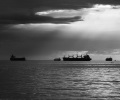Trailblazing modern sailing ship gets green light from global shipping body

A trailblazing design for technology that could power 21st-century cargo sailing ships has won the backing of a major global shipping body.
Oceanbird is working on a wing sail concept that uses the same aerodynamic forces that keep aircraft in the sky to power ships, as part of a drive to cut the global industry’s carbon emissions.
The Swedish company has now secured what is known as Approval in Principle from DNV, the world’s biggest ship classification society. This sets standards for construction and safety, paving the way for a prototype wing sail to be fitted to a ship.
DNV’s approval of Oceanbird’s design comes as the race is hotting up tap into the market for wind-powered ships, after the UN’s International Maritime Organisation agreed a net-zero commitment for the reduction of greenhouse gases from the world’s cargo shipping.
Cargo ship Pyxis Ocean, fitted with WindWings sails designed and developed by UK-based BAR Technologies, recently made its maiden voyage from China to Brazil.
While the Pyxis Ocean’s WindWings are retrofitted to provide propulsion that saves fuel, Oceanbird has plans for a 90 per cent wind-powered ship with an ability to sail into the wind at an angle of as low as five degrees.
Oceanbird’s managing director Niclas Dahl said the company has managed to get AiP in just a year and a half, a feat he described as “amazing”.
“This is a great milestone to show we’re on the right track and will allow us to soon go from spread sheet to real steel,” he told The National.
An Approval in Principle is an independent assessment of a concept confirming that the design is feasible and has no significant obstacles to prevent the concept from being realised.
DNV looked at how the wing could handle extreme conditions, such as heavy wind loads, snow and ice loads and waves on deck, as well as its control systems.
Mr Dahl said the key part of the AiP was being able to show that the wing sails could be lowered in excessively high winds for safety “under any circumstances” given destabilising effect that can have on the ship.
“The crew of ships will want to have them down when you have winds of 100 knots (185kph) and they will feel much safer,” he said.
“In the AiP, you need to have Plan A, Plan B and Plan C to show you can always bring them down.”
The first new vessel using its technology will be a car transporter, also able to carry cargo, built by one of Oceanbird’s two parent companies, Swedish-Norwegian shipbuilder Wallenius Wilhelmsen.
The 220m vessel will come equipped with six wing sails and will be able to carry 7,000 cars, anywhere in the world, say officials.
In the meantime, a prototype wing sail will be fitted to a ship for more testing.
“We still need to go through type approval but this is one very major step,” said Mr Dahl.
Currently, the vast majority of the world’s 100,000 cargo ships – which carry 90 per cent of the world’s goods – are powered by engines that are often the size of four-storey houses and fuelled by polluting heavy oil.
The two 37m WindWings fitted to the cargo deck of the Pyxis Ocean, which is chartered by Cargill, are expected to generate fuel and emissions savings of 30 per cent.
Cargill, one of the world’s biggest ship charterers, has been exploring wind assisted propulsion as one cleaner energy option.
WindWings’ designer BAR Technologies was spun out of Sir Ben Ainslie’s team for the 2017 America’s Cup – a competition that has been dubbed the ‘Formula One of the seas’.
The wings were fitted by Norway-headquartered Yara Marine, and the two companies are planning to build hundreds of wings over the next four years.
Cargill’s president of ocean transportation Jan Dieleman said he believes “this technology is a game changer”.
BAR chief executive John Cooper said the Pyxis Ocean’s voyage showed that wind power need not slow down ships.
He said the ship powered its engines right down to save fuel but with the help of wind power “got to 16 knots, which is quicker than the vessel can go with full combustion engines”.
Richard Pemberton, lecturer in mechanical and marine engineering design at the University of Plymouth, in south-west England, said the race was on to make the technology work on a large scale.
“There’s more of a drive and once there’s the first one, that makes it easier for the other,” he told The National.
He explained the extent to which wind-powered ships can succeed, as opposed to those using carbon-neutral fuels, depends on whether they can work in complex global supply chains.
“Until there’s that one clear example of it working and everyone is happy with it, then it’s going to be hard to get that mass adoption,” said Dr Pemberton.
Source: The National
